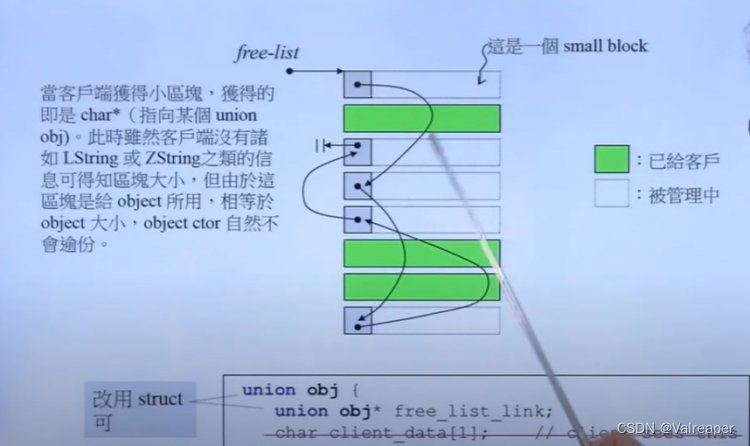-
内存池中的嵌入式指针
嵌入式指针 可以union改struct 内存分配后 next指针就没用了 直接作为数据空间比较省内存 因为对指针指向的内存存储的时候 编译器是不管你是什么类型的 ,这里有道练习题可以对指针的概念稍微理解一下:
#include <iostream> using std::cout; using std::endl; class A { public: int j = 5; int i = 1; void exec() { i = 2; } }; class B { public: int i = 3; int j = 6; void exec() { i = 4; } } ; int main(){ A a; B *bp = (B *)&a; B b = *bp; cout<<a.i << bp->i << b.i<<endl; bp->exec(); cout<<a.i <<bp->i << b.i<<endl ; b.exec(); cout<<a.i << bp->i << b.i<<endl ; }- 1
- 2
- 3
- 4
- 5
- 6
- 7
- 8
- 9
- 10
- 11
- 12
- 13
- 14
- 15
- 16
- 17
- 18
- 19
- 20
- 21
- 22
- 23
- 24
- 25
- 26
- 27
- 28
由于嵌入式指针节省内存的特点 几乎所有的内存池都会使用
内存池一般不是为了提高效率而是为了减少cookie,设想一下节省100万个指针的存储会节省多少空间。

#include<iostream> using namespace std; class TestEP { public: int m_i; int m_j; public: struct obj //结构 //定义一个类型,不放在外部,污染全局变量 { //成员,是个指针 struct obj* next; //这个next就是个嵌入式指针 //自己是一个obj结构对象,那么把自己这个对象的next指针指向 另外一个obj结构对象,最终,把多个自己这种类型的对象通过链串起来; }; }; int main() { TestEP mytest; cout << sizeof(mytest) << endl; //8 TestEP::obj* ptemp; //定义一个指针 ptemp = (TestEP::obj*)&mytest; //把对象mytest首地址给了这个指针ptemp,这个指针ptemp指向对象mytest首地址; cout << sizeof(ptemp->next) << endl; //4 cout << sizeof(TestEP::obj) << endl; //4 ptemp->next = nullptr; return 1; }- 1
- 2
- 3
- 4
- 5
- 6
- 7
- 8
- 9
- 10
- 11
- 12
- 13
- 14
- 15
- 16
- 17
- 18
- 19
- 20
- 21
- 22
- 23
- 24
- 25
- 26
- 27
- 28
- 29
-
相关阅读:
如何通过内网穿透实现远程连接NAS群晖drive并挂载电脑硬盘?
《JAVA EE》内部类(上篇)
分布式系统的发展历程
[WPF] 假装可变字体
毫米波雷达模块的目标检测与跟踪
架构师的 36 项修炼第08讲:高可用系统架构设计
extcon驱动及其在USB驱动中的应用
【LayaAir2.0】LayaAir2.0新手入门指南(目录)
家政服务行业做开发微信小程序可以实现什么功能
RocketMQ实战之在线停机和扩容
- 原文地址:https://blog.csdn.net/weixin_43862733/article/details/125430482